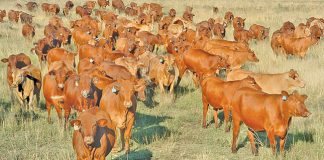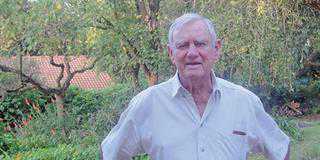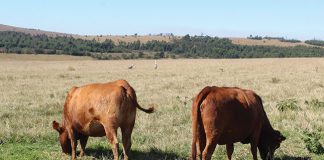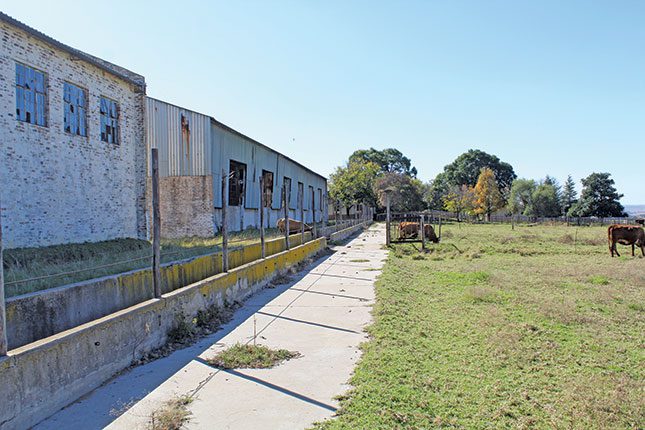
Photo: Lindi Botha
As a young boy, Petros Sibanyoni grew up watching the success of commercial farmers in the Olifantsfontein area of Gauteng. Some of his friends worked on the farms and Sibanyoni was captivated by their reports, convinced that there was a future in farming. “I watched those farmers expanding their operations over the years and that inspired me to work towards the same goal,” he relates.
While still in school he started a vegetable garden at home and assisted his father in tending to his goats. His heart was set on livestock farming, but after school it became apparent that starting a farm from scratch, without land, a herd or any collateral for a loan, would not be possible.
Not losing sight of his goal, he worked as an insurance salesman, saving until he could rent a piece of land in 2003. “But that left me without money to buy cattle. So I went and cried on my uncle’s shoulder — he had a large herd — until he eventually gave me a cow,” he laughs.
Sibanyoni slowly built up his herd, but setbacks were not far off. “One night, two of my cows were stolen out of the kraal. I was so despondent after working so hard to buy those animals, I started sleeping in the kraal just to keep them safe.”
Sibanyoni epitomises the struggles faced by many an emerging farmer. The passion and drive are there, but capital is not. With no collateral to offer the banks, loans have evaded him. “Growth happens very slowly when you don’t have financing,” he laments.
While government programmes and grants to support emerging farmers are available in theory, Sibanyoni explains that this also takes time.
“You have to keep knocking on doors so that they know you’re serious about farming. But even so, grants come with their own problems. You are beholden to their plans and ideas.
There’s little room to implement site-specific plans.
“Then there’s the issue of corruption, which is so rife there is little benefit in receiving the grant in the first place. Once you get involved in that cycle of corruption and having to pay bribes along the way, where does it end? You can’t move forward like that.”
Forging ahead
In 2008, Sibanyoni moved to a farm in the Witbank region, which he rents from government. The size of his cattle herd has fluctuated over the years and he currently has 45 cows, having recently sold his bull to prevent inbreeding. He also has about the same number of sheep, and plants vegetables on a spare patch of land.
The farm, however, has far more potential, with several outbuildings, kraals, and cattle handling and feedlot infrastructure. Though it is in a state of deterioration, Sibanyoni believes that with a bit of financing it can be revamped into a decent-sized feedlot.
“All the infrastructure is already here and nothing will need to be built from scratch. The farm is next to the N4 highway so there’s easy access to all the main routes. There’s so much potential, if I can just get it going, I’ll be unstoppable!”
Knocking on government doors was not entirely in vain and did add cattle to his herd through a development programme for emerging farmers. The Bonsmara cattle were a valuable asset, fetching good returns for the heavy carcasses, but Sibanyoni has come to realise that heavy cattle require a lot of feed.
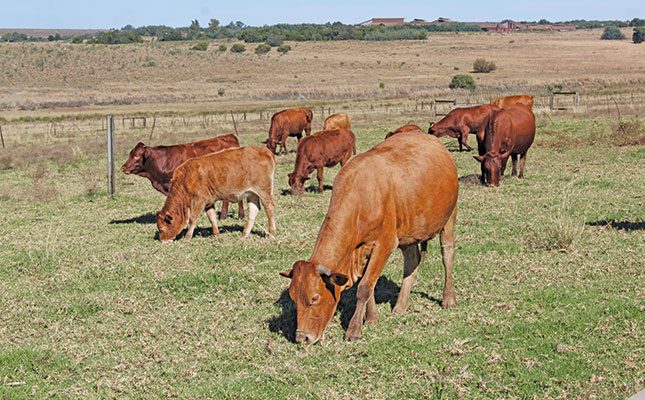
“The Bonsmara is a great breed if you have the right resources, but for an emerging farmer with little to spend on expensive feed rations, it doesn’t pay.”
This is why he has chosen to manage the size of his herd according to the feed availability of the farm rather than have a larger herd, but with skinny animals. “An animal whose ribs are showing is not a good sight to behold,” he says.
He is currently looking for a Tuli or Boran bull to breed animals that will maintain condition even when the veld quality is poor.
While sheep are kept in kraals close to the house for security reasons, cattle graze the veld on both sides of the municipal road that splits the farm.
On the house’s side, the camps have kikuyu grass, which wanes in winter. Ideally the cattle would then be left opposite the road to graze the sweet and sourveld in the winter, but this carries another risk: veld fires.
“The larger part of the farm is across the road, where the land is mostly unattended. Fires often break out in the winter and if I’m not vigilant, by the time I can move my cattle it can be too late.”
Sibanyoni has a herder who must watch for fires but also manage the cattle to ensure optimal grazing. Because the veld type is mixed, it is important to keep the cattle on the land long enough for them to eat their fill of all types of graze, but not decimate it to a point where both the animals and cattle suffer. Just as important is allowing the cattle to stay long enough in areas where grass is lush.
The cattle only receive licks in winter. When veld conditions are too poor in the cold weather to sustain the herd, they are given hay bales that Sibanyoni cuts in summer, in addition to a grain supplement.
Cows calve from August to December; those with good structure are kept, and the rest sold on auction. Sibanyoni prefers this market to a feedlot, as he gets a better price for his animals.
“But the beef price has decreased considerably. The price offered at auctions nowadays is so low it’s almost not worth it. Load-shedding has played a massive role in the profitability of farming. Butcheries don’t want to keep a lot of stock, so demand for carcasses has diminished. No one in the value chain can operate at full capacity at this stage because it’s just too risky with load-shedding to have freezers full of meat.”
Sibanyoni had to give up on farming broilers earlier this year for the same reason, as prices reached unprofitable levels.
Despite the setbacks, Sibanyoni is persevering. In 2019 he received the award for the Agricultural Research Council’s National Emerging Beef Farmer of the Year for Mpumalanga. Judges were especially impressed with his record-keeping and management of his herd. He hopes to do a course in financial administration and feed management to improve his skills even further and increase his chances of succeeding as a commercial farmer.
“I am surviving because my electricity is on and my children are in school. Those are the two things I won’t compromise on, so much of my income goes towards that.”
The farm is fortunate to have ample water, but electricity is required for the borehole pumps. The kraals near the house are also lit at night to enhance security. To lighten the load, Sibanyoni has applied for three-phase electricity to bring down his Eskom bill. He also plans on buying a generator to aid during load-shedding, as solar power is a far greater investment.
Finding other ways of earning an extra income to put towards growing the farm is another way he is working towards his dream. Using his grass-cutting equipment, he offers gardening services to the surrounding businesses and mines. He stresses, however, that it is important to balance these extra activities with farming to ensure that the herd, and his primary goal, is not neglected.
Any income received is managed with diligence and Sibanyoni stresses the importance of being honest with oneself about finances.
“When a few animals are sold and a large sum of money is gained at once, it’s important to plough that money back into the business immediately. Don’t kid yourself into thinking it’s a bonus to be spent on luxuries.”
Financial transformation
Sibanyoni admits that the issue around financing emerging farmers is complex, as beliefs about this – some false, some true – reduce the likelihood of black farmers receiving financing.
“There are those who grow up in poverty, and when they suddenly get money in the form of a grant or loan they squander it because the temptation to buy things they never had previously is too great. Then loans don’t get paid back because the money was never invested for the intended purpose. The next time a black farmer wants to lend money, he is judged according to those who defaulted on their loans. So there’s a prejudice against them.
“We’re not judged as individuals, only as numbers and letters on an application form, all judged according to the same standard.”
Sibanyoni believes it will be a long time for the banks to get past this prejudice.
“Loans officers need to get out of their offices and onto the farms to judge each case individually, and see for themselves what’s really going on on the applicant’s farm. But banks don’t seem to want to spend money on employing people to do site visits.”
For now, Sibanyoni says that he, like many other emerging farmers, is stuck in a cycle of poverty that is difficult to escape. “I’ve got so many ideas and plans to expand and add value, but without financing it remains a dream.”
However, he remains positive about the future of the cattle industry. “There’s a lot of potential considering the population growth and future demand for beef. I love livestock and I’ll keep persevering.”
Phone Petros Sibanyoni on 082 688 2621.











